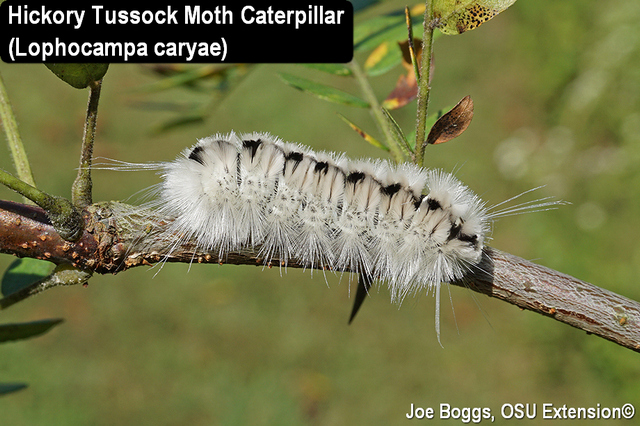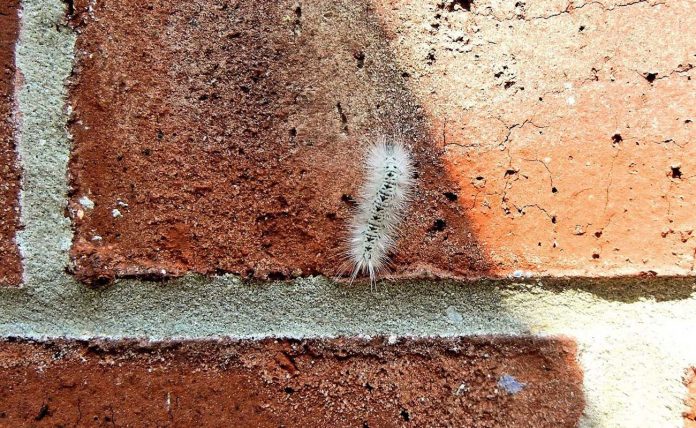My brother and I used to search high and low for caterpillars in the fall. We found a lot of woolly bears hiding in and around wood stacks as my parents always heated our home with wood. And sometimes we would come across other interesting caterpillars.
More often than not our finds would be harmless, but occasionally, our interactions with certain caterpillars would cause a rash and some swelling. One instance I remember vividly was a massive rash my brother ended up with that covered the length of his forearm.
We were thrilled to find a fluffy white caterpillar with a black stripe down its back. Hayden spotted it and so he was first to touch it. He picked it up and allowed it to crawl from his hand along his arm to almost his elbow. As the caterpillar neared his elbow, he noticed a rash forming along the caterpillar’s trail and flicked it off. Ten minutes later, the caterpillar’s trail was marked by a bright red rash and noticeable swelling. That was the last time we played with fuzzy white and black caterpillars.
It’s best to be cautious when you spot hairy or bristled caterpillars because there are venomous and non-venomous varieties found in Ohio that can cause injury. You should only handle them if you are able to correctly identify the caterpillar and know it poses no threat.
Stinging hairs and bristles
Some fuzzy caterpillars use their hair, bristles or both as defense mechanisms and cause caterpillar dermatitis in one of two ways. The first way is when hairs or bristles puncture the skin and break off to cause mechanical injury via a rash and swelling like my brother experienced when he came into contact with the hickory tussock moth caterpillar. The second way they cause dermatitis is when hairs and bristles that puncture the skin and inject venom.
Non-venomous caterpillars that cause skin irritation
Hickory Tussock Moth Caterpillar

Appearance. Fuzzy, white and black caterpillars that are often seen in the fall.
Location. They are found primarily in northeastern North America from Maine to North Carolina and west to Wisconsin and Illinois.
Habitat. Hickory, walnuts, pecan and American hornbeam are this caterpillar’s preferred hosts. It can also be found on ash, elm, oak, willow and maple. It’s likely they can feed on most hardwood deciduous trees.
Venom. These caterpillars are not venomous; however, they can cause skin irritation when their barbed hairs easily detach and become embedded in skin.
White-Marked Tussock Moth caterpillar

Appearance. This caterpillar has lateral black and yellow stripes with red dots running along the black stripes. It has four white tufts of hair on its back and thinner patches of white bristles along its sides. It has a red head with two long patches of black hair on either side and a brown patch of hair on its butt.
Location. The white-marked tussock moth caterpillar can be found in the eastern portion of the United States from Maine to Florida and west to Minnesota.
Habitat. Some of the more common plant hosts include apple, basswood, elm, maple, oak, pear, plums, poplars, redbud, rose, sycamore, walnut and willow.
Venom. This is another non-venomous caterpillar that can cause skin irritation when its hairs and bristles break off and become embedded in skin.
Venomous caterpillars
Smaller Parasa

Appearance. This caterpillar is brown and slug-like with retractable bristles protruding from its front and hindquarters.
Location. The smaller parasa can be found from New York to Florida and west to Missouri and Mississippi.
Habitat. It eats woody plants, such as apple trees, dogwood, elms and oaks.
Venom. The smaller parasa’s envenomating bristles remain almost hidden until it is disturbed. However, if disturbed these bristles pop out and provide a decent amount of venom for the caterpillar’s small size.
Saddleback caterpillar

Appearance. Saddleback caterpillars have a slug-like body form and bright warning colors that denote toxicity. They are dark brown on the front and hind ends with a contrasting bright green pattern covering their midsections. Their midsection is bordered with white markings that outline a brown saddle-like shape in the center. They also have large fleshy horns that extend from both ends, which are covered in long hairs and venomous bristles. On the hind end, a cream-colored set of spots imitates a large facial area.
Location. These caterpillars can be found all across the eastern United States from New York and Massachusetts to Florida and west to Wisconsin and parts of Iowa, Kansas, Nebraska, Oklahoma and Texas.
Habitat. The saddleback caterpillar has a wide range of host plants, including maples, holly, palms, sunflowers, artichoke, hackberry, dogwood, blueberry, cranberry, huckleberry, lingonberry, chestnut, pecan, spicebush, crape myrtle, Chinese hibiscus, rubber fig, West Indes mahogany, orchid, sweet corn, coral vine, macadamia nut, apple trees, crabapple, black cherry, pear trees, bitter orange, grapefruit, sweet orange, kumquat, false buckthorn, elms, grapevines and more.
Venom. Saddleback caterpillars are one of the dangerous venomous caterpillars with their large spines and hemolytic and vesicating (blistering) venoms. Saddleback stings are intensely painful causing a sharp burning sensation that may last for a prolonged period over a large area. Other sting symptoms include migraines, gastrointestinal symptoms, asthma complications, anaphylactic shock, rupturing of red blood cells and hemorrhaging. Although more often than not saddleback stings are not life-threatening, seeking medical attention is advised.
Crowned Slug caterpillar

Appearance. Crowned Slug caterpillars are flat and oval with small suction cup feet. They are pastel green with plumes of stinging hairs around the perimeter and shorter stinging hairs on top. There are two pale lines that run down their backs and terminate in a pair of horns out front and a pair of stinging plumes on their rears.
Location. It is found from Massachusetts and southern Ontario to Florida and west to Missouri and Mississippi.
Habitat. Crowned slug caterpillars feed on a variety of hardwoods, including cherry, elm, hickory, beech, linden, maple, oak, Prunus species, Norway maple and other trees and shrubs.
Venom. The crowned Slug is rarely encountered, however, it has been known to fall off of host plants onto unexpecting victims because its small suction-cup feet aren’t always effective in keeping them stuck to the leaves of their host. A crowned slug sting is described as being similar to a yellowjacket sting.
Hag Moth caterpillar

Appearance. Hag moth caterpillars, also called monkey slugs, are light to dark brown in color. Their stinging hairs are located on curved and twisted, variable-length, lateral spines. The appearance of these spines, which is similar to long, disheveled hair, is how the hag moth caterpillar got its name.
Location. It can be found from Maine and Quebec to Florida and west to Nebraska, Arkansas and Mississippi.
Habitat. Its host plants include apple trees, ashes, birches, chestnut, dogwoods, hickories, oaks, persimmon, willows and other woody plants.
Venom. The hag moth’s spines have toxin glands at their base, which is released upon contact. Sting symptoms can vary in severity and include burning or stinging, itching, redness and inflammation. Allergic reactions are possible but not common.
White Flannel Moth caterpillar

Appearance. The white flannel moth caterpillar has a yellow body, marked with a wide black stripe that runs the length of its midsection and red at each end. It also has 11 pairs of raised yellow tufts that run along this midsection and bear short stinging hairs and smaller tufts along each side of its body. Its long silky hairs do not sting, but its shorter needle-like hairs at the base of each tuft do.
Location. The white flannel moth caterpillar is found from Washington, D.C. to Florida and west to Montana and Texas. Outside of the United States, its range extends further south through Mexico, Guatemala and Panama to Venezuela, Suriname and Bolivia.
Habitat. These caterpillars commonly feed on hackberry, beech, black locust, elm, green briar, mimosa and redbud.
Venom. Coming into contact with a white flannel moth caterpillar causes its stinging hairs to break and release venom that causes pain equivalent to a wasp or bee sting and blisters that can last up to a few hours.
Black-Waved Flannel Moth caterpillar

Appearance. The black-waved flannel moth caterpillar appears soft and harmless, but its long, wispy hairs hide short stinging bristles beneath. Early in its larval stage, this caterpillar is fuzzy and covered with white wispy hairs. It appears almost like a caterpillar covered in cotton candy. As it matures, shorter, velvety hairs grow in place of the wispy white hairs. During both stages, the stinging setae that defend the caterpillar from predatory contact are hidden beneath. The color of the caterpillar can vary from bright white to brown, rusty orange, gray and yellow.
Location. This caterpillar’s range extends from the eastern part of Canada down into Mexico, cutting through the center of the United States from North Dakota to Texas.
Habitat. This caterpillar’s hosts include alder, apple, birches, blackberry, Myrica species, oaks, poplars, Prunus species, sassafras, willows and other trees and shrubs.
Venom. The black-waved flannel moth caterpillar’s stinging hairs embed themselves into skin, causing pain that tends to worsen after initial contact. A red pattern that matches the outline of the caterpillar’s body is typically visible after contact. Symptoms of this caterpillar’s sting can include redness, pain that radiates to other body parts, irritation, nausea, seizures and muscle spasms. The severity of the symptoms depends on the sensitivity of the victim, where they were stung and how many spines were embedded into their skin. Those with allergies are more at risk and should seek medical attention
Io Moth caterpillar

Appearance. Young larvae are orange and most often seen in groups. As they mature they become yellowish green to bluish green with red-and-white stripes down their sides. They are thickly covered with tufts of bristly, stinging spines
Location. This caterpillar can be found from southern Canada throughout the eastern U.S. and south into eastern Mexico. They can be found as far west as Colorado.
Habitat. Io Moth caterpillars feed on maples, boxelder, alders, birches, hickories, hackberries, redbud, bayberries, wax myrtles, aspen, poplars, cottonwood, cherries, pear tears, currants, gooseberries, blackberries, sassafras, willows, basswoods, elms and wisteria.
Venom. Io Moth caterpillars are covered in venomous spines that break off and embed themselves in skin to release the venom. Some entomologists believe the broken spines produce a two-pronged reaction — the chitin left in the skin causes an inflammatory, itchy, immune response while the venom causes other damage. Although the venom of this caterpillar has not been well studied, the symptoms of coming into contact with it are typically described as feeling like being stung by a bee followed by itchy welts.
Resources
- Stinging Cats, Ohio State Extension
- Venomous Caterpillars, Ohio State Extension
- Saddleback Caterpillar, University of Florida
- Hickory Tussock Moth Caterpillar, Penn State Extension
- Io Moth, University of Florida
- Butterflies and Moths of North America
- NC State Extension
- Stinging Caterpillars, University of Kentucky
- Stinging and Venomous Caterpillars of the Southwest, University of Florida












